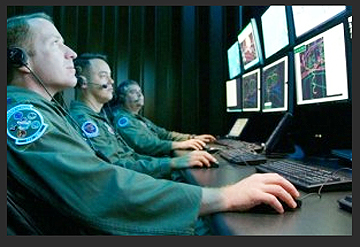 Set in the year 2023, the Schriever Wargame 2012 International Game (SW12 IG) was the first game in the series history that used a combined team led by NATO and Australian forces. The wargame explored critical space issues in-depth and investigated the integration activities of multiple agencies associated with space systems and services. The SW12 IG scenario depicted NATO/Australia combined counter-piracy operations around the Horn of Africa. Operation JOLLY ROGER was a notional operation supporting a multi-national task force charged with finding and stopping Horn of Africa piracy operations. Those piracy operations were supported by—and were supporting—al Shabaab, a notional al Qaeda affiliate in Africa. The countries involved in the counter-piracy operation included Australia and the NATO nations of Canada, Denmark, France, Germany, Italy, Netherlands, Turkey, the United Kingdom, and the United States.
Set in the year 2023, the Schriever Wargame 2012 International Game (SW12 IG) was the first game in the series history that used a combined team led by NATO and Australian forces. The wargame explored critical space issues in-depth and investigated the integration activities of multiple agencies associated with space systems and services. The SW12 IG scenario depicted NATO/Australia combined counter-piracy operations around the Horn of Africa. Operation JOLLY ROGER was a notional operation supporting a multi-national task force charged with finding and stopping Horn of Africa piracy operations. Those piracy operations were supported by—and were supporting—al Shabaab, a notional al Qaeda affiliate in Africa. The countries involved in the counter-piracy operation included Australia and the NATO nations of Canada, Denmark, France, Germany, Italy, Netherlands, Turkey, the United Kingdom, and the United States.
“The U.S. Air Force cannot fight precisely without space assets and without preparing for the potential disruption or denial of critical space systems used by U.S and allied forces,” said Brigadier General Samuel A. Greaves, Director of Plans, Programs and Analyses at Air Force Space Command, Peterson AFB, Colorado. “The Schriever Wargame gives the U.S. Air Force and space-mission partners a better idea of how to protect space assets from adversaries and how to better integrate space systems throughout our national and international security community.”
The general explained that while exercises are training events for existing forces using near-term scenarios at the tactical level; wargames look to the future, primarily at the operational level and above, to identify future force planning requirements and systems integration. “During the wargame scenario, NATO nations and Australia provided capabilities to boost space situational awareness; improve Intelligence, Surveillance, and Reconnaissance efforts; enhance environmental monitoring, and increase communications bandwidth,” said General Greaves.
The objectives of the wargame centered on: 1) examining options of how to optimize space efforts from participating NATO allies and Australia in support of a notional NATO expeditionary operation; 2) identifying ways to increase the resilience of space capabilities in a contested environment through expanded international and private-sector cooperation and coordination; 3) determining operational challenges associated with defense of space capabilities employed in support of the operation; 4) examining the operational integration of cyber into defense of the space domain; and 5) expanding understanding of the operational benefits of broader international participation in combined space operations.
The wargame series began more than 10 years ago with Schriever 2001, which was designed as a key instrument to explore future space issues and integrate space capabilities throughout the national security community. Over the years, the wargame series continued the tradition, focusing on examining space and cyberspace policy, rules of engagement, and protection of space capabilities. The wargame results are classified. However, an unclassified final report will be available in approximately six months. The results must be briefed within DoD and the participating agencies before results can be publicly released. The unclassified NATO report will be made available once cleared for public release.

